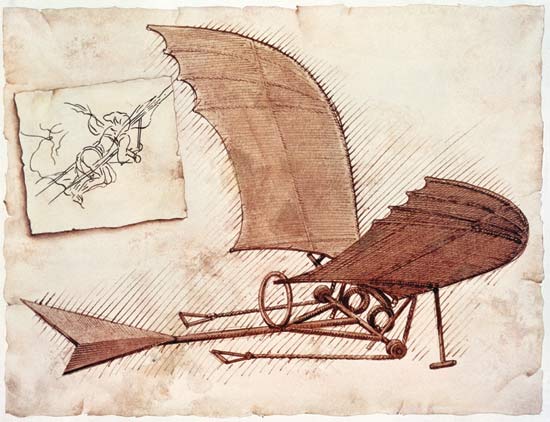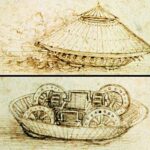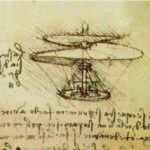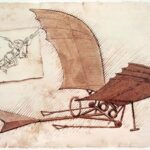Did Leonardo da Vinci invent the glider
Table 1. Summary of the Leonardo da Vinci Glider:
| Section | Key Points |
|---|---|
| Introduction | – Brief background on Leonardo da Vinci and his fascination with flight. |
| Leonardo da Vinci’s Experiments with Flight | – Discussed da Vinci’s glider concept, addressed whether he invented the glider, and explored the timeline of his flight inventions. |
| Leonardo da Vinci’s Other Aerial Inventions | – Explained the function of the ornithopter, investigated whether it would have worked, and whether da Vinci invented the propeller. |
| Historical Context of Glider Invention | – Identified the official inventor of the first working glider and discussed the feasibility of da Vinci’s glider design. |
| Leonardo da Vinci’s Flight Legacy | – Highlighted da Vinci’s enduring impact on today’s aviation technology and described his flying machine models and sketches. |
| Conclusion | – Summarized the discussion on da Vinci’s fascination with flight, his experiments with flight, his other aerial inventions, and his flight legacy. |
I. Introduction
Born in 1452 in the town of Vinci, Italy, Leonardo da Vinci showed a keen interest in the world around him from a young age. His interests were incredibly varied, spanning from painting and sculpture to anatomy and architecture. His curiosity even extended to the sky. The concept of flight, in particular, held a special fascination for him, prompting countless sketches and models of various flying machines.
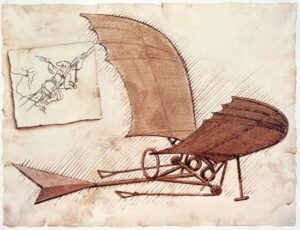
Leonardo da Vinci Glider
Leonardo’s fascination with flight was more than a whimsical dream; it was a deep-rooted desire to explore the bounds of human potential. Begin an exploration to understand Leonardo da Vinci’s fascination with flight, which spurred his creation of groundbreaking inventions such as the Leonardo da Vinci Glider and Leonardo da Vinci Ornithopter.
II. Leonardo da Vinci Flight
I) The Concept of the Leonardo da Vinci Glider
Among his most remarkable sketches is the design of a glider. Inspired by birds’ structure and their way of soaring high in the sky, Leonardo sought to design a machine that could imitate this flight.
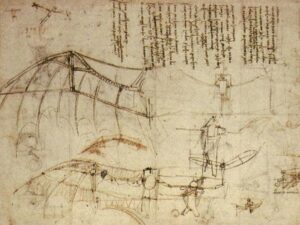
Leonardo da Vinci’s Glider Sketch
The Leonardo da Vinci glider was a device that focused on aerodynamics long before the term was even coined. It was designed to use wind currents, similar to modern hang gliders, with a wingspan considerably larger than the body. This wingspan would capture wind currents to provide lift, while the pilot’s body lying flat would reduce air resistance. Leonardo’s glider design was a testament to his brilliance, displaying an instinctive understanding of flight principles centuries before their formal discovery.
II) Did Leonardo da Vinci Invent the Glider?
The question that follows naturally is – did Leonardo da Vinci indeed invent the glider? The answer, much like the man himself, is complex.
While Leonardo certainly sketched a design for a glider, there is no evidence that he ever built or tested a functioning model. It’s also important to remember that the concept of gliding flight was understood and utilized by nature long before humans ever took to the skies. Birds, insects, and even some species of fish and mammals use the principles of gliding flight.
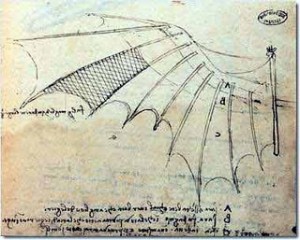
Leonardo da Vinci’s Batwing Sketch with Proportions
III) The Timeline of Leonardo da Vinci’s Flight Inventions
Leonardo da Vinci’s works on flight spanned his entire career. But when exactly did he come up with his innovative glider concept? While pinpointing an exact date is challenging due to the fragmentary nature of Leonardo’s notebooks, scholars agree that his most intense period of flight study occurred from 1488 to 1514.
It was during this time that Leonardo’s interest in birds and flight began to morph into the more mechanical approach he’s famous for today. His numerous sketches and designs for flying machines, including the Leonardo da Vinci glider and the Leonardo da Vinci ornithopter, provide testament to his intense study during this period.
III. Leonardo da Vinci’s Other Aerial Inventions
I) The Ornithopter Leonardo da Vinci
Among Leonardo da Vinci’s numerous flight designs, the ornithopter holds a special place. Unlike the glider, which was designed to glide passively through the air, the ornithopter represented a more ambitious project: achieving powered, flapping-wing flight similar to a bird.
An ornithopter is a machine designed to achieve flight by flapping its wings. The word itself originates from the Greek words ‘ornithos’ meaning bird and ‘pteron’ meaning wing. Leonardo da Vinci’s ornithopter design comprised large wings that would flap while being operated by a pilot lying down in the machine’s center. This invention showed his careful study of bird flight and his creativity in mimicking their flapping wings.
II) The Functionality of Ornithopter da Vinci
Would Leonardo’s ornithopter have actually flown? The question has puzzled scholars and aviation enthusiasts alike. While it’s fascinating to imagine such a machine soaring in the skies of Renaissance Italy, the consensus among historians is that it would have been unlikely.
Leonardo’s design relied on the pilot’s muscle power to generate enough lift to take off and maintain flight, which, given the size and weight of the machine, would have been practically impossible. Nevertheless, the Leonardo da Vinci ornithopter remains a brilliant conceptual exercise, a leap of imagination that was centuries ahead of its time.
III) Did da Vinci invent the propeller?
Yet another aspect of Leonardo’s aerial inventions that stirs curiosity is the propeller. Did the Renaissance genius indeed invent this vital component of modern aviation?
Leonardo da Vinci’s notebooks contain sketches of spiral-shaped air screws, which bear an uncanny resemblance to modern-day propellers. The concept behind his design was simple yet revolutionary: when turned quickly, the air screw would generate lift, pulling the device – and potentially its occupant – upwards into the air.
IV. The Historical Context of Glider Invention
I) Who Invented the First Glider?
The history of aviation is a fascinating tapestry of innovation, with many brilliant minds contributing to its development. While Leonardo da Vinci’s sketches provide the earliest recorded designs of gliders, the title of “official inventor of the first working glider” is attributed to someone else.
The first glider capable of carrying a human on board was built by George Cayley in 1853, several centuries after Leonardo da Vinci’s time. Cayley’s glider was a full-sized biplane design, flown by a ten-year-old boy. Despite its humble origins, this moment marked a significant milestone in the evolution of flight, paving the way for modern aviation.
II) Would da Vinci Glider Work?
With the benefit of modern knowledge and technology, it’s tempting to ask: could Leonardo da Vinci’s glider have worked? Would his design, as recorded in his notebooks, have achieved the soaring flight he imagined?
Leonardo’s glider was based on a observation of bird flight. With large wings meant to provide lift and a tail to stabilize direction, his design was fundamentally sound. However, without the benefit of understanding the principles of aerodynamics and the material technology available to us today, building a functional model from his sketches would have been challenging in his lifetime.
The video is taken from a BBC documentary showing how Leonardo da Vinci’s Glider could actually work while being built with materials and tools Leonardo would have had access to. The only addition to the original design is a rudder, during previous attempts at flight the glider would try to turn sideways, the rudder stops this from happening.
Interestingly, modern recreations of Leonardo’s glider using materials he had at his disposal, like wood and canvas, have shown that it may have been capable of limited, uncontrolled glides. This gives us a hint that Leonardo da Vinci, with his glider design, was certainly on the right track, even if he lacked the means to fully realize his dream of human flight.
V. Leonardo da Vinci’s Flight Legacy
I) Da Vinci’s Influence on Modern Aviation
Leonardo da Vinci, with his pioneering designs and undying curiosity, has left a profound and enduring impact on modern aviation. Though his designs were not constructed during his lifetime, the seeds of innovation he planted continue to bear fruit in our era.
Da Vinci’s flying machine designs encompassed several key principles of flight, including lift, thrust, and control surfaces. These principles, though unrefined during his time, have become the bedrock upon which modern aviation stands. Every plane, helicopter, and drone flying today owes a small part of its existence to the groundwork laid by Leonardo da Vinci. Indeed, his influence underscores the importance of the historical context of glider invention in our understanding of flight.
II) Models and Sketches of Da Vinci’s Flying Machines
Da Vinci’s sketches, kept in his private notebooks, reveal a rich collection of designs and concepts for flying machines. Among these, one particular design stands out: the ‘Da Vinci Airplane’.
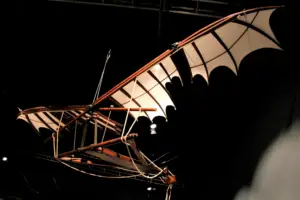
Leonardo da Vinci Airplane Model
The ‘Da Vinci Airplane’ is a remarkable sketch featuring a large, broad wing structure, a pointed front for reducing air resistance, and intricate systems meant to flap the wings. With its bird-like aesthetics, it reflects da Vinci’s continuous inspiration from nature and his relentless quest to unlock the secrets of flight.
While the ‘Da Vinci Airplane’ might not have been practical or functional with the technology of his time, it has nevertheless sparked the imagination of countless inventors and engineers across the centuries. Modern reconstructions and interpretations of da Vinci’s designs serve as a testament to his timeless genius and his enduring flight legacy.
Conclusion
From his foray into the world of flight, Leonardo da Vinci has given us a wealth of ideas, sketches, and principles to ponder. While not all of his ideas were realized or deemed practical during his time, his unquenchable thirst for understanding the mysteries of flight has unquestionably left a lasting legacy on the field of aviation.
In this exploration, we have delved into da Vinci’s fascination with flight, scrutinized his glider concept, discussed the possibility of him being credited as the inventor of the glider, and traced the timeline of his aerial inventions. We have also attempted to understand his other aerial inventions like the ornithopter and whether his designs would have been functional in reality.
Though da Vinci’s designs were centuries ahead of their time, they remain an integral part of our collective imagination and a testament to the human spirit’s ceaseless pursuit of flight. To put it in plain words, the fascination with Leonardo da Vinci’s flight legacy is not about whether his machines could have flown, but about the audacious, innovative spirit they represent, still inspiring engineers, inventors, and dreamers today.
